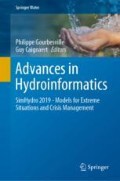Abstract
The present paper is devoted to the analysis of the impact of a raindrop on water. The studied configuration is focused on the effects of high energy splash regimes, caused by the impact of large droplets at high velocity. Such cases, which mimic raindrops falling on the surface of the ocean at their terminal speed, are characterized by short time scales and complex mechanisms, and they have received little attention until now. The GERRIS opensource solver is used to perform three-dimensional simulations of the impact. The capabilities of octree adaptive mesh refinement enable to capture the small-scale features of the flow, while the Volume Of Fluid (VOF) approach combined with a balanced force surface tension calculation is applied to advect the volume fraction of liquid and reconstruct the interfaces. A post-processing of the results has been developed to identify each object resulting from the splash and characterize their evolution in time. Specifically, the contour of the liquid/gas structure created at the impact is reconstructed as well as the size and position of the ligaments and droplets aerosolized in the atmosphere. The results are compared to experimental data obtained previously by Murphy et al. (J Fluid Mech 780:536–577): both the crown formation above the cavity created by the impact, the ligaments emanating from the rim at the top of the crown, and the downward liquid jet that pierces through the bottom of the cavity, are correctly reproduced by the model. A very good quantitative agreement is also obtained regarding the time evolution of the crown dimensions, including its closure after the initial phase of expansion.
Access this chapter
Tax calculation will be finalised at checkout
Purchases are for personal use only
References
Worthington AM (1882) On impact with a liquid surface. Proc R Soc Lond 25:217–230
Schotland RM (1960) Experimental results relating to the coalescence of water drops with water surfaces. Discuss Faraday Soc 30:72–77. https://doi.org/10.1039/df9603000072
Engel OG (1966) Crater depth in fluid impacts. J Appl Phys 37:1798–1808. https://doi.org/10.1063/1.1708605
Murphy DW, Li C, d’Albignac V, Morra D, Katz J (2015) Splash behaviour and oily marine aerosol production by raindrops impacting oil slicks. J Fluid Mech 780:536–577. https://doi.org/10.1017/jfm.2015.431
Bisighini A, Cossali GE, Tropea C, Roisman IV (2010) Crater evolution after the impact of a drop onto a semi-infinite liquid target. Phys Rev E 82:036319
Popinet S (2003) Gerris: a tree-based adaptive solver for the incompressible Euler equations in complex geometries. J Comput Phys 190(2):572–600
Scardovelli R, Zaleski S (2000) Analytical relations connecting linear interfaces and volume fractions in rectangular grids. J Comput Phys 164(1):228–237
Popinet S (2009) An accurate adaptive solver for surface-tension-driven interfacial flows. J Comput Phys 228:5838–5868
DeBar, R.: Fundamentals of the KRAKEN code. Technical report, UCID-17366, California University, Lawrence Livermore National Laboratory, Livermore, USA (1974)
Aulisa E, Manservisi S, Scardovelli R, Zaleski S (2007) Interface reconstruction with least-squares fit and split advection in three-dimensional Cartesian geometry. J Comput Phys 225(2):2301–2319
Francois M, Cummins S, Dendy E, Kothe D, Sicilian J, Williams M (2006) A balanced-force algorithm for continuous and sharp interfacial surface tension models within a volume tracking framework. J Comput Phys 213(1):141–173
Brackbill J, Kothe DB, Zemach C (1992) A continuum method for modeling surface tension. J Comput Phys 100:335–354
Samet H (1989) Applications of spatial data structures. Addison-Wesley Publishing Company, Reading
Khokhlov AM (1998) Fully threaded tree algorithms for adaptive refinement fluid dynamics simulations. J Comput Phys 143(2):519–543
Author information
Authors and Affiliations
Corresponding author
Editor information
Editors and Affiliations
Rights and permissions
Copyright information
© 2020 Springer Nature Singapore Pte Ltd.
About this paper
Cite this paper
Ghandour, M.H., Bayeul-Lainé, AC., Coutier-Delgosha, O. (2020). Analysis of High Energy Impact of a Raindrop on Water. In: Gourbesville, P., Caignaert, G. (eds) Advances in Hydroinformatics. Springer Water. Springer, Singapore. https://doi.org/10.1007/978-981-15-5436-0_69
Download citation
DOI: https://doi.org/10.1007/978-981-15-5436-0_69
Published:
Publisher Name: Springer, Singapore
Print ISBN: 978-981-15-5435-3
Online ISBN: 978-981-15-5436-0
eBook Packages: Mathematics and StatisticsMathematics and Statistics (R0)

